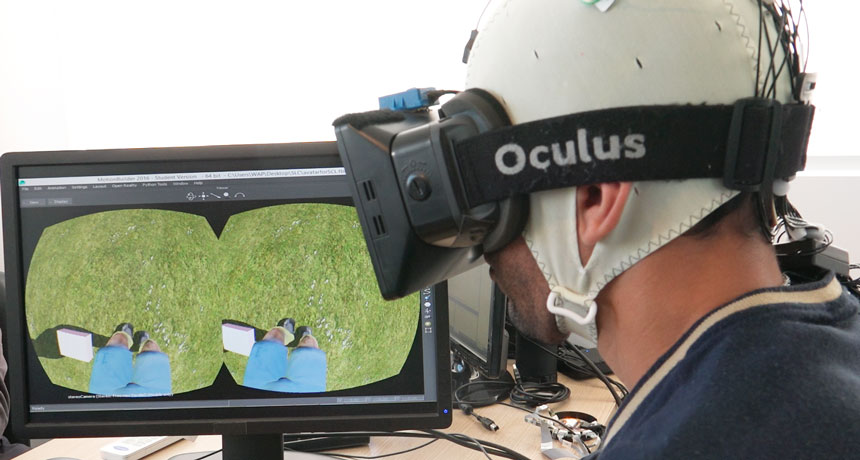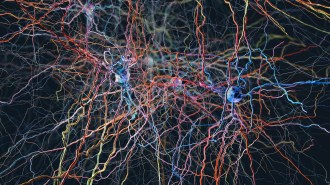Mix of brain training, physical therapy can help paralyzed patients
After year of treatment, paraplegics regain some muscle control, feeling

LEARNING TO WALK A patient wearing virtual reality goggles and a cap that captures signals from the brain can use thoughts to control the movement of an avatar. Such brain training helped paraplegics in a new study regain some feeling and function.
AASDAP, Lente Viva Filmes
Training the brain could give paraplegics more control over their bodies.
After a year working with devices that link machine to brain, people paralyzed by spinal cord injuries were able to regain some movement and feeling in their legs, Miguel Nicolelis and colleagues report August 11 in Scientific Reports.
The training included an assortment of therapies with futuristic-looking gizmos, including virtual reality goggles and robotic exoskeletons that fasten over the body. All patients were better able to sense pain and touch, and half had their diagnosis upgraded from complete to partial paralysis.
“This is a very key milestone in the field of brain-machine interfaces,” Nicolelis said in a news briefing August 9.
But some scientists aren’t convinced that it’s such an advance.
Researchers have already proposed (and demonstrated) the benefits of brain-machine interface technology before, says Brendan Allison, a neuroscientist at the University of California, San Diego. While the new work is impressive and stands out for such long-term brain training, he says, “it’s simply not a breakthrough.”
Paralyzing spinal cord injuries can sever the bundle of nerves that carries messages from the brain to the body. So even if the brain tells the toes to move, the message dead-ends when it hits the injury site. For people with these severe injuries, there’s not much doctors can do to help, said Nicolelis, of Duke University. “They basically just try to get you adapted to life in a wheelchair.”
In 2012, he and colleagues started a project to help paraplegics walk, with assistance. With a stretchy cap placed over their heads to capture brain signals, patients would use their thoughts to control an exoskeleton, a robotic walker that held their bodies upright. The device would give paraplegics some mobility again — at least that was the goal. What the team found was far more exciting, Nicolelis said.
For one year, Nicolelis’ team worked with eight people who had been paralyzed for between three and 13 years. Twice a week for one hour, patients trained on a variety of rehabilitation tools. They learned how to control an avatar in virtual reality by imagining moving their legs, and later, how to use the brain-controlled exoskeleton. Patients also did hours of traditional physical therapy, including strengthening and stretching exercises.
BRAIN CONTROLLED A person paralyzed by a spinal cord injury can make a robotic exoskeleton walk — using signals gathered from the brain and sent to the machine. AASDAP and Lente Viva Filmes, São Paulo, Brazil |
About seven months into the project, the researchers noticed that all patients were beginning to regain control of one or more muscles below their spinal cord injury. And after 12 months, all patients experienced improvements in sensing touch and pain. One woman even gave birth to a child, and could feel the contractions during the delivery, Nicolelis said.
Though all patients had severe spinal cord injuries, he thinks some nerve cells must have survived and that the training rekindled their activity.
The amount of clinical recovery “is almost like a dream,” Nicolelis said. It may be enough to upgrade brain-machine interfaces, he said, from an assistive therapy (something that helps people walk — like crutches or a cane) to something that actually that helps people recover.
Again, that’s not a new idea, says Donatella Mattia, a neurophysiologist at the Institute for Research and Health Care in Rome. Other scientists working with paralyzed stroke patients have already shown improvements in arm mobility after using brain-machine interfaces.
What’s more, teasing out cause and effect in the new study isn’t easy, says University of Houston neural engineer José Contreras-Vidal. Patients underwent a complicated blend of therapies, with different lengths of training. Despite the caveats, though, he thinks the work is a step forward. And in clinical research, he says, “even incremental is good.”






